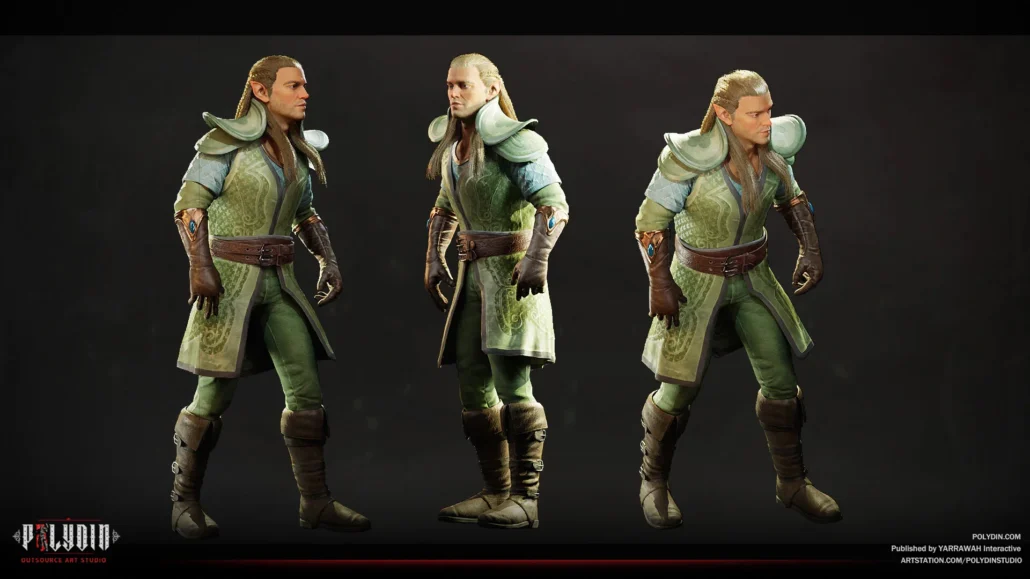Creating a fun game is the holy grail of game development-a goal that blends creativity, psychology, and technical skill into an experience that players can’t put down. But making your game fun isn’t a one-size-fits-all formula; it’s a craft that requires an understanding of what grabs players and keeps them coming back for more. Whether you’re making an indie title or a AAA blockbuster, fun is the heartbeat of success. This article from Polydin Game Art Outsourcing Studio explores the key elements of making your game fun, from storytelling and progression to missions, environments, AI, social features, and controls. Let’s look at how to turn your vision into player delight.
Understanding What “Fun” Means in Games
Before tackling how to make your game fun, you need to define “fun.” It’s subjective—some players crave adrenaline-pumping challenges, others seek immersive stories, and many love social connection. Fun often stems from a mix of engagement, satisfaction, and surprise. Games like The Legend of Zelda: Breath of the Wild nail exploration with vast landscapes, while Among Us thrives on social deduction and betrayal.
To master how to make your game fun, identify your target audience—casual mobile gamers or hardcore PC players—and what drives their enjoyment, like competition or escapism. Then build every mechanic around that core. Test early with playtesters, gather feedback on what feels rewarding—be it loot or laughs—and refine relentlessly to ensure your game clicks.
Develop a Captivating Storyline
A great story can elevate a game from good to unforgettable, and it’s a cornerstone of how to make your game fun.
Crafting Engaging Narratives
Start with a premise that grabs attention—think The Last of Us and its post-apocalyptic father-daughter bond. When figuring out how to make your game fun, weave a narrative that gives players purpose, whether it’s saving the world, seeking revenge, or solving a cosmic mystery. Use dialogue, cutscenes, or environmental game storytelling—like notes scattered in Dark Souls or audio logs in Dead Space—to draw players in without overwhelming them. Keep pacing tight so the story unfolds naturally alongside gameplay, and consider optional lore for depth, like Mass Effect’s codex entries.
Building Complex Characters
Characters are the soul of your story. To master how to make your game fun, create protagonists and NPCs with depth—flaws, motivations, and growth. Think of Geralt from The Witcher 3, whose gruff exterior hides a moral compass, or Ellie from The Last of Us Part II, wrestling with grief. Give them unique voices, quirky traits—like Borderlands’s eccentric cast—and backstories players can uncover through side quests or banter, making every interaction meaningful. Emotional investment keeps players hooked.

Incorporating Unexpected Twists
Surprise keeps players on their toes. In how to make your game fun, twists—like the betrayal in BioShock’s “Would you kindly?” moment or the identity reveal in Knights of the Old Republic—add excitement and replay value. Plan twists that fit your narrative, avoiding cheap shocks, and foreshadow subtly with clues like cryptic NPC dialogue or hidden journals to reward attentive players. A well-timed twist can turn a good game into a classic.
Implement Rewarding Progression Systems
Progression keeps players hooked by making them feel accomplished—a key part of how to make your game fun.
Designing Balanced Reward Structures
Rewards should match effort. When exploring how to make your game fun, offer loot, experience points, or currency at a pace that feels fair—like Destiny 2’s loot drops after tough raids or Stardew Valley’s steady farm upgrades. Avoid over-rewarding (which cheapens success) or under-rewarding (which frustrates), and tie rewards to milestones—boss kills, level-ups, or story beats—for maximum impact. Test drop rates to find the sweet spot, ensuring players feel the grind pays off.
Offering Skill Upgrades and Unlocks
Let players grow stronger or unlock new abilities. In Hollow Knight, new moves like the dash expand exploration, while Diablo IV offers skill trees for customization—both show how to make your game fun through empowerment. game Balance upgrades so they enhance gameplay without breaking it—cap power creep with diminishing returns—and offer choices like stealth perks or brute force to suit different playstyles, keeping progression personal and engaging.
Providing Visual and Cosmetic Rewards
Visual flair motivates players. To nail how to make your game fun, include skins, weapon designs, or titles—like Overwatch’s golden guns or Fortnite’s wild outfits—that let players flaunt their achievements. These don’t affect balance but add a layer of personal expression. Consider seasonal events with exclusive cosmetics, like Apex Legends’s themed skins, to keep the community buzzing year-round and drive retention.
Create Engaging and Varied Missions
Missions are where players live your game, so variety and challenge are critical in how to make your game fun.
Diversifying Mission Types
Mix it up—combat, stealth, puzzles, or exploration. Grand Theft Auto V blends heists with races, while Portal 2 shifts between physics puzzles and narrative beats, showing how to make your game fun by avoiding monotony. Tailor missions to your game’s strengths—fast-paced shooters need action, RPGs need quests—and tie them to the story for cohesion. Add optional objectives, like bonus loot or secret paths, to spice things up and reward curiosity.
Balancing Difficulty Levels
Difficulty should challenge without alienating. When learning how to make your game fun, scale encounters—like Elden Ring’s bosses or Celeste’s precision platforming—so they test skill but offer a fair shot at success. Include difficulty options, assist modes—like Stardew Valley’s relaxed pace—or dynamic scaling—like Hades’s adaptive enemy waves—to cater to casual and hardcore players. Playtest with diverse skill levels to ensure accessibility without diluting the thrill.
Encouraging Replayability
Replay value extends fun. To master how to make your game fun, add branching paths, side quests, or random events—like Skyrim’s radiant quests or Dead Cells’s procedurally generated runs. Unlockable modes, harder difficulties, or New Game+ features—like in Resident Evil 2—keep players returning to explore what they missed or test their mastery. Hidden endings, like in Chrono Trigger, can also boost replay appeal.
Utilize Dynamic Environments and Realistic Graphics
A captivating world pulls players in, making it a vital aspect of how to make your game fun.
Designing Interactive and Immersive Worlds
Build environments players can touch—breakable objects, climbable surfaces, or hidden secrets. Red Dead Redemption 2’s living frontier, with its huntable wildlife and chatty NPCs, shows how to make your game fun with interactivity. Add physics-based elements—like barrels that explode in DOOM—and lore-rich details, like graffiti or abandoned camps, to make every corner feel alive. Include Easter eggs or collectibles to encourage thorough exploration.
Day-Night Cycles and Weather Effects
Dynamic systems add realism and strategy. In how to make your game fun, use day-night cycles—like Minecraft’s hostile nights—or weather that impacts gameplay, such as rain slowing movement in Ghost of Tsushima or fog hiding enemies in Returnal. These keep the world fresh, unpredictable, and tactically engaging—test how they affect balance to avoid frustration, like ensuring visibility isn’t too punishing.
High-Quality Graphics
Visuals set the mood. To excel at how to make your game fun, aim for graphics that match your vision—stylized like Cuphead’s 1930s cartoon vibe or photorealistic like Cyberpunk 2077’s neon sprawl. Optimize for performance—smooth framerates trump ultra-high detail on low-end systems—and use lighting, like Control’s eerie shadows or Disco Elysium’s painterly effects, to enhance atmosphere without sacrificing playability.
Develop Challenging Yet Fair AI
Smart AI turns enemies into worthy foes, a crucial element in how to make your game fun.
Creating Adaptive AI Behaviors
AI should react, not just repeat. In Half-Life 2, Combine soldiers flank and adapt, while FEAR’s replicas coordinate assaults—both show how to make your game fun with dynamic foes. Program AI to respond to player tactics—retreating when outmatched, calling reinforcements, or exploiting mistakes—making battles feel alive. Avoid overcomplicating AI if your budget’s tight; focus on a few smart behaviors that shine.
Ensuring Balanced Difficulty
Fairness keeps frustration at bay. When mastering how to make your game fun, tune AI so it challenges without cheating—like avoiding omniscient enemies in DOOM Eternal or overpowered stats in Bloodborne. Test with real players to ensure it’s tough but winnable with skill, tweaking health, speed, or aggression as needed to hit that sweet spot.
Avoiding Predictable Patterns
Predictability kills tension. To perfect how to make your game fun, mix AI routines—randomize attacks, add ambushes like Left 4 Dead’s special infected, or include rare “elite” enemies with unique moves. Unpredictable foes keep players alert, guessing, and engaged—use playtesting to spot and break any loops that form over time.
Encourage Social Interaction and Multiplayer Options
Connection amplifies fun, making social features a big part of how to make your game fun.
Integrating Cooperative and Competitive Modes
Multiplayer adds layers—co-op like It Takes Two’s quirky teamwork or PvP like Rocket League’s high-octane matches. In how to make your game fun, offer both, letting players team up or face off, with matchmaking that’s quick and balanced—avoid long queues or skill mismatches. Add co-op puzzles, like Overcooked’s chaotic kitchens, or PvP arenas to diversify play and keep groups entertained.

Implementing Leaderboards and Social Rankings
Competition drives replayability. To nail how to make your game fun, add leaderboards—like Tetris 99’s rankings—or guild systems to showcase skill, like World of Warcraft’s PvP ladders. Keep them fair with anti-cheat measures and refresh them seasonally with rewards—like medals or badges—to fuel friendly rivalries and bragging rights.
Facilitating In-Game Communication
Social bonds keep players invested. When learning how to make your game fun, include chat, emotes, or voice—like Apex Legends’ ping system or Phasmophobia’s proximity chat—so teamwork flows naturally. Add moderation tools—muting or reporting—to curb toxicity, ensuring a positive vibe that retains players and builds a thriving community.
Prioritize Smooth Controls and User-Friendly Interfaces
A game’s feel can make or break it, so controls are central to how to make your game fun.
Designing Intuitive Control Schemes
Controls should feel second nature. In Super Mario Odyssey, simple inputs yield complex moves, while Hades maps attacks fluidly—both show how to make your game fun with intuition. Map actions logically—jump on A, attack on B—avoid clutter, and support controllers, keyboards, or touch seamlessly. Test with newbies to spot confusion and refine until it’s effortless.
Ensuring Responsive Touch Controls
For mobile or hybrid games, touch matters. To master how to make your game fun, ensure taps and swipes—like in Genshin Impact or Brawl Stars—register instantly, with clear hitboxes, no lag, and visual feedback like ripples or glows. Minimize accidental inputs with dead zones around edges and test on various devices for consistency.
Providing Adjustable Sensitivity Settings
Customization keeps players comfortable. When perfecting how to make your game fun, offer sliders for mouse, joystick, or touch sensitivity—like Call of Duty: Warzone or Apex Legends—so everyone can tweak to their liking. Add aim assist options for accessibility, ensuring precision and control for all skill levels, from novices to pros.
Conclusion
Knowing how to make your game fun is about blending art and science—crafting a world where story, progression, missions, visuals, AI, social play, and controls work in harmony. It’s not just about flashy features but creating an experience that resonates, whether through a gripping tale, a rewarding grind, or a friend-filled match. Test relentlessly with diverse players, listen to their joys and gripes, and iterate until every moment sparkles. With these strategies, you’re not just building a game—you’re crafting joy that lasts. So, dive in and discover how to make your game fun for players everywhere.



